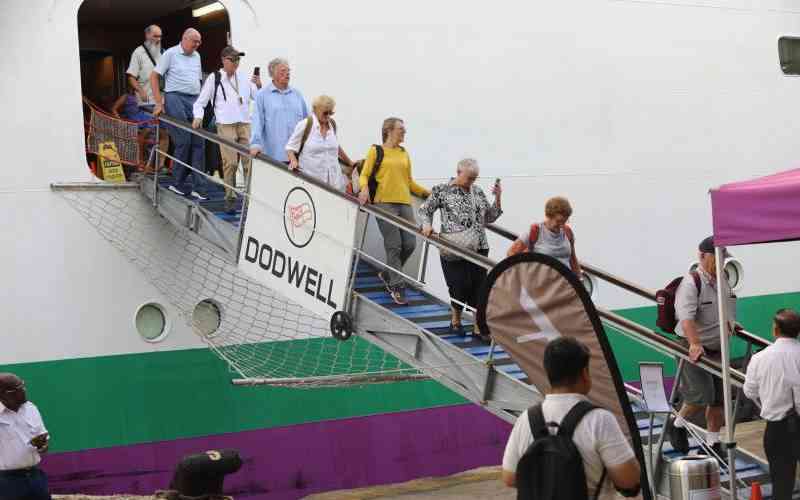By Amos Kareithi
The coral stones jutting out of rugged coastline have conspired with the abrasive waves, ceaselessly beating against the unyielding beach to keep unwanted visitors out of the island. Each step inching into the island has to be fought for and a miscalculation can send a barefoot walker tumbling into the blue waters.
Any stranger lured by the serene greenery finds soon enough that Wasini is not a walk in the park. Nonetheless, its prisinine coral gardens are a scene to behold. Here, goats peacefully graze, aware that they may be forced to retreat to higher ground up the mangrove forest when the tidal waves come to submerge their pastures.
Unlike many other islands along the expansive Kenyan coastline, the enclave has proved to be irresistible but impenetrable just as it did more than 400 years when no member of the local community was willing to venture there. The only way into the island is through a boat ride that takes about 10 minutes from the mainland at Shimoni that is 15km off the Likoni-Lunga Lunga Road.
Sorrowful past
Despite the vanguard waves roaring and scaring away any unwanted visitors, they have done little to drown the sorrowful past; whose echoes have haunted the place and arrested development. This past mixture of adventure and hope mixed with pain can only be brought alive by a few gifted locals who effortlessly roll back the layers of history dating more than four centuries back to recapture life as it was then. One such custodian of heritage is 26-year-old Iddi Bakari, who has become a repository of history and acts as a bridge between the past, the present and the future.
His eyes light up as he excitedly recounts the rich history of his people. He speaks of centuries of intrigue; hope and despair as the rich and the powerful struggled for control of the people and resources of Wasini. “A long time ago, the island of Wasini was inhabited by the Digo community. They were however captured and sold as slaves by Arabs who invaded the place. The remaining indigenous people fled to the caves of Shimoni.”
Historians estimate that a people called Wavumba, from a place called Vumba Kuu 400 years ago, first occupied the island. They were however forced by circumstances to flee, leaving the place uninhabited.
The Wavumba, the historians add, were no match for the battle-hardened Wagalla and the Maasai who raided the settlement at will as at different points they were the indomitable warriors of East Africa.
Some of the Wavumba people who escaped the spears of the mighty warriors retreated to Kigomoni in Tanzania. They would later come back to the island and were engaged in lucrative trade with the Chinese, who brought their most valued currency in ancient times – porcelain – which they exchanged for fish and mangrove poles.
Unsuitable for habitation
“The Arabs from Yemen, Omani, Pemba and Zanzibar later raided the island. The new masters joined the Wavumba in trading with the Chinese traders, which gave the island its new name. Originally it was known as Vumba Island, but was changed to Wasini, to mean short Chinese people,” Bakari explains.
National Musuems of Kenya curator, Patrick Ambungu, who is in charge of Shimoni and Wasini areas, which are rich heritage sites, backs this narrative. Abungu explains that after the Arabs invaded the island from Migombani in Tanzania, they dominated the locals and sold them off as slaves before occupying the area.
“There is a possibility many of the original inhabitants were sold as slaves. This place was during the slave trade inhabited by the Arabs who had permanent homes at Zanzibar,” he explains.
Mr Abungu’s observation that the inhabitants were sold as slaves is backed by the existence of some prison-like structures just next to the shoreline near a mosque that was constructed in 1700. The mosque’s blue and while glittering walls belies its age and continues to attract locals for prayers every time its loud speakers blare.
Stay informed. Subscribe to our newsletter
Although some ancient structures belong to this epoch, they are all unsuitable for human habitation. Some of the roofless buildings have however been reclaimed by fishermen who store their nets during the day after a long night in the Indian Ocean waters looking for fish.
The ancient buildings that have no roof are located just next to the waterline and overlooks Shimoni mainland, which was appropriately named so because of its natural caves. It was in these caves that slaves captured from the hinterland were held captive; waiting for ships from Zanzibar to ferry them to international slaves market in Middle East, Far East and European markets. Owing to its proximity to Zanzibar, as it is only three hours away by boat, Wasini, became a base for notorious slave masters.
They would lock up all the slaves they captured in Shimoni and then retreat to Wasini to await the arrival of their merchant ship from Zanzibar. Since the caves were quite secure, the slave traders would lock them up at Shimoni and ride to Wasini where they had their own settlement. Any slaves who tried to escape from Shimoni were brought to Wasini, and locked up in the prison.
Remnants of the prison are still evident in the island where rusted pieces of iron that acted as handcuffs are still cemented to the walls. Some of the residential buildings are suspected to have acted as warehouses for storing cloves for the onward journey to other international markets. It was impossible to escape from the island that is eight kilometres long and four kilometres wide as its land is made up of coral stones that are very sharp and inhibits any movement on bare foot.
Dwindling fortunes
The island’s fortunes just like all other coastal settlements that served as slave market started dwindling after Britain successfully campaigned for the abolition of slave trade. Even after the slave trade was abolished, Wasini, which would later be claimed by the Germans after the partition of Africa in the 1880s, remained part of Tanzania until it was violently taken over by Britain.
During the Second World War, some of the residents recall how most of its buildings were demolished after the British who were based at Shimoni bombarded it. Some old ordinances used during this war, Bakari explains, have been discovered in the island and serve as a reminder of when it was part of German East Africa.
However, the island became part of Kenya’s territory after independence in 1963 and some residents recount how the islands history has been haunting them to date. Abdurahim Said, a resident of Wasini says that for a long time, the Government treated the inhabitants of Wasini suspiciously. “Getting a national identity card for us has not been easy because an applicant has to produce an affidavit and proof that he or she is truly a Kenyan. We have suffered,” Said observes.
While in the past the inhabitants of Wasini mainly resided in Pemba and occasionally visited Wasini, currently the island’s 3,000 residents have migrated to Mombasa. “The development of this place has stagnated. Most of the people reside in Mombasa Old Town and only come here to visit.
However, this is likely to change and once again Wasini will shine,” Said says. Said’s hope in Wasini is demonstrated by the big home he is constructing just next to an ancient mosque, a stone throw away from the beach. But as he and other residents hope to ride on a wave of eco-tourism that has started cascading the area, he will have to contend with basic problems like lack of electricity and educational facilities.
Perhaps this explains why almost 50 years after independence, no vehicle has ever set foot in the island that is yet to have a secondary school. Despite being cocooned in a time warp that seems to have frozen civilisation as we know it today, life in Wasini has not always been dull as there was a time it has a hub of a very lucrative trade. The locals are banking on Wasini’s resilience in the past to ride through whatever waves of challenges destiny may throw its way so that it lives for many more centuries as it has done before.
[email protected]
 The Standard Group Plc is a
multi-media organization with investments in media platforms spanning newspaper
print operations, television, radio broadcasting, digital and online services. The
Standard Group is recognized as a leading multi-media house in Kenya with a key
influence in matters of national and international interest.
The Standard Group Plc is a
multi-media organization with investments in media platforms spanning newspaper
print operations, television, radio broadcasting, digital and online services. The
Standard Group is recognized as a leading multi-media house in Kenya with a key
influence in matters of national and international interest.
 The Standard Group Plc is a
multi-media organization with investments in media platforms spanning newspaper
print operations, television, radio broadcasting, digital and online services. The
Standard Group is recognized as a leading multi-media house in Kenya with a key
influence in matters of national and international interest.
The Standard Group Plc is a
multi-media organization with investments in media platforms spanning newspaper
print operations, television, radio broadcasting, digital and online services. The
Standard Group is recognized as a leading multi-media house in Kenya with a key
influence in matters of national and international interest.








